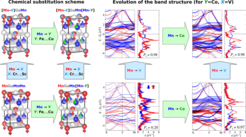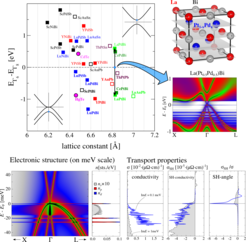Spin-selective localization. Our first-principles studies of the random chemical occupation which typically occurs in polyatomic systems such as Heusler alloys, have shown a principal possibility to manipulate almost independently by different components of the linear-response conductivity tensor. These effects might provide an alternative resource of materials with high spin-polarization as it is often required in spintronics. Their principal difference from the conventionally exploited systems with analogical functionality (so-called half-metals, due to the absence of the conduction electrons of a certain spin) is the presence of the spin-selective localization [1, 2, 3] which implies a strong disorder scattering of conducting electrons in one spin-channel and extremely weak scattering in another one. Being based on the different mechanism, their high spin-polarization can then be combined with additional properties which are incompatible in the ordered systems, such as conventional half-metals – high spin-polarization and broad variability of their magnetization combined with a strong magnetocrystalline anisotropy. FIG.1 shows how different chemical substitutions of Mn in Mn3Ga by other 3d transition elements lead to the localization of the spin-down electronic states in the vicinity of the Fermi energy.

By first-principles calculations of the spin-resolved residual conductivities based on the Kubo-Greenwood formalism, we show that the spin-polarization Pz (along the c-axis of a tetragonal unit cell) might be dramatically increased by using already a very small substitution rates as shown in FIG.2. In the metallic regime Pz depends much stronger on the ratio of the spin-resolved electron mobilities rather than on spin-resolved concentrations of conducting electrons. Our latest studies on other Heusler systems, e.g. Mn3-xPtxGa series, indicate that the spin-selective localization is rather widely spread phenomenon, which occurs in a large number of tetragonal and cubic Mn-based Heusler alloys.

Large spin-Hall angles. The focus of this study is the first-priniciples modeling of the nonmagnetic systems with a large spin-Hall angle (defined as a ratio between the spin-Hall and longitudinal DC currents). The candidate materials (3D Dirac semimetals) can be found in the family of the 18-valence electron Hesuler compounds (also called "half-Heuslers" due to a regular vacancy in one of the Wyckoff positions) by tuning chemical composition to the borderline between trivial and nontrivial topological phases (upper half of FIG.3). At the borderline composition, the appropriate chemical disorder (which conserves the number of valence electrons per formula unit to be fixed to 18) imposes the impurity-like resonant states (note, for a given example of the 50-50 random chemical mixture, one cannot identify the impurities in terms of distinct atoms, however the impurity-like states do exist) directly at the Fermi energy (lower half of FIG.3), which strongly suppresses the DC electric current, but at the same time, retains and even amplifies the spin-Hall current components which allows to achieve a large spin-Hall angle (see arXiv:1510.06935). This mechanism might also provide an alternative source of the topologically nontrivial semiconductors within the zinc-blende and Heusler families which typically do not exhibit a clear semiconducting behavior in the bulk due to the orbital degeneracy caused by their cubic symmetry [4, 5].



